It closed on December 4, the exhibition Della Robbia. Sculpting with Color in Renaissance Florence, curated by Marietta Cambareri, at the Museum of Fine Arts, Boston. It will reopen Feb. 5 at the National Gallery of Art in Washington, D.C., where it will be on view until June 4. The exhibition is intended to be a more than 100-year-long tour through the technique of glazed earthenware. The history of this medium begins in the 1530s in Florence, when Luca della Robbia, after comparing himself with Donatello in the creation of the cantorie for Santa Maria del Fiore, invented and specialized in a new production. After him, his nephew Andrea and the latter’s son, Giovanni, would continue the family tradition, spreading glazed terracotta (or “robbiane”) beyond the municipal borders and perfecting the technique.
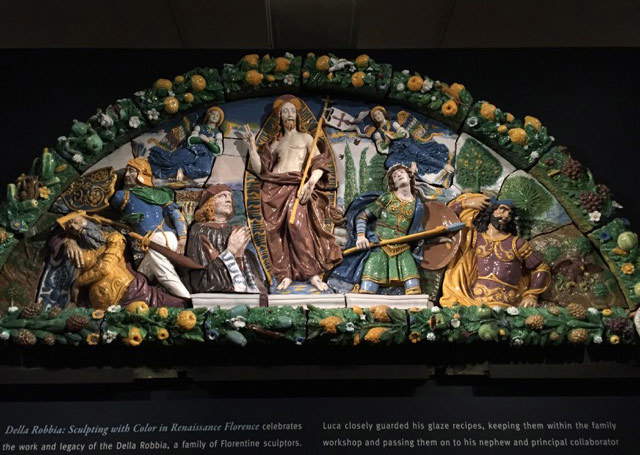 |
| Della Robbia. Sculpting with Color in Renaissance Florence will reopen Feb. 5 in Washington, D.C. |
The birth of these particular sculptures (or “glass figures,” as they were perceived by contemporaries) still remains shrouded in mystery. Certainly, diagnostic investigations and pioneering studies have added much to our knowledge of these artifacts, yet we still know little about what they looked like before firing. What is certain is that their production is closely linked to the place where they were born: the particular composition of the clay from the Arno, rich in minerals, made them objects that could not be reproduced except by resorting to the same material. Also contributing to their fortune was their peculiar nature, halfway between painting and sculpture; with the former they shared the use of color, with the latter three-dimensionality. Conversely, glazing made these works more durable than a painting, but also cheaper than a marble work.
The Boston show is divided into three sections, titled after the three cardinal virtues, and forgoes a precise chronological scanning (which would perhaps have been pedantic) to propose, instead, some categorizations into which the works in the exhibition fall. Starting from private devotion and domestic settings, through public placements and dialogue with the antique, the visitor is taken along a path of discovery of the techniques and dynamics of a workshop that remained unique for a long time. What unites all the works in the exhibition, most of which come from American museums, is their high quality and excellent state of preservation.
The exhibition opens with an extraordinary relief depicting the Resurrection of Christ by Giovanni, the youngest member of the family to try his hand at this technique, now in the 16th century. The white and blue reliefs of his great-uncle Luke give way to a much wider chromatic variety that now includes green, brown and purple. The uniqueness of this lunette also lies in its prestigious provenance. In fact, two Antinori coats of arms (a Florentine family that still produces wine and generously sponsored the exhibition) are clearly visible in the rich garland of fruit that surrounds the scene. Documentary research has confirmed the original location of this relief, composed of more than forty pieces, and which once decorated the doorway of a villa in the Tuscan countryside. Within the very rich garland, made up of sixteen distinct sections, Giovanni tried his hand at depicting various plants, even resorting to casts from life. In addition to the plant world, it also contains a wide variety of small animals that seem to chase each other and almost made on purpose to entertain the little ones during the visit. Also in the exhibition are numerous Madonnas with Child and Nativities, themes peculiar to private devotion, which also see small updates and a gradual addition of colors as generations pass and techniques improve.
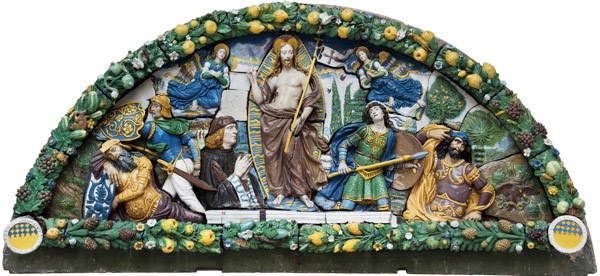 |
| Giovanni della Robbia, Resurrection (ca. 1500-1524; glazed terracotta, 174.6 x 364.5 x 33 cm; New York, Brooklyn Museum) |
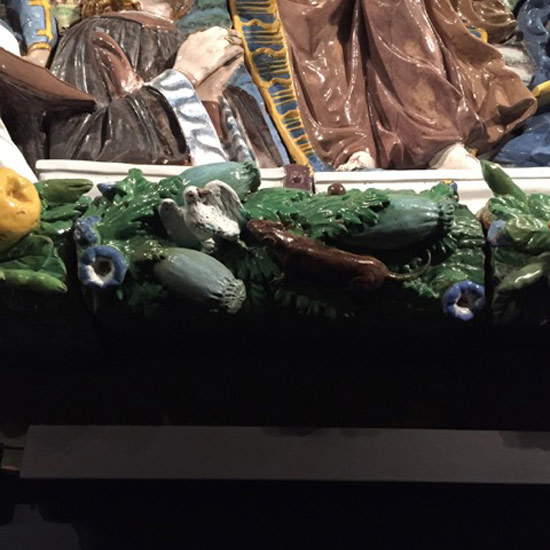 |
| Detail of Resurrection |
Stunning, even in its monochrome, is the Visitation from the Pistoiese church of San Giovanni Fuorcivitas, a masterpiece from the 1540s by the progenitor Luca. This work, whose original arrangement is attempted to be alluded to by placing it on a podium and framing it in a niche, can also be dismantled into pieces, but the joints are cleverly concealed by the artist within the folds of the robes of the two female figures. The meeting of the Virgin and St. Elizabeth, and the consequent upheaval of St. John the Baptist sensing the Savior near him, in another womb, are rendered with a particular iconography: the older Elizabeth falls on her knees and embraces her cousin, leaving visible to the gaze of the faithful, who are also kneeling before the altar, the face of the young Mary.
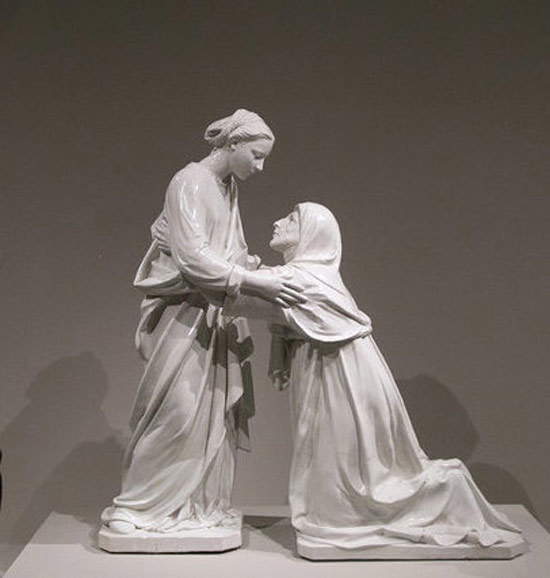 |
| Luca della Robbia, Visitation (c. 1445; glazed terracotta, height 184 cm; Pistoia, San Giovanni Fuorcivitas) |
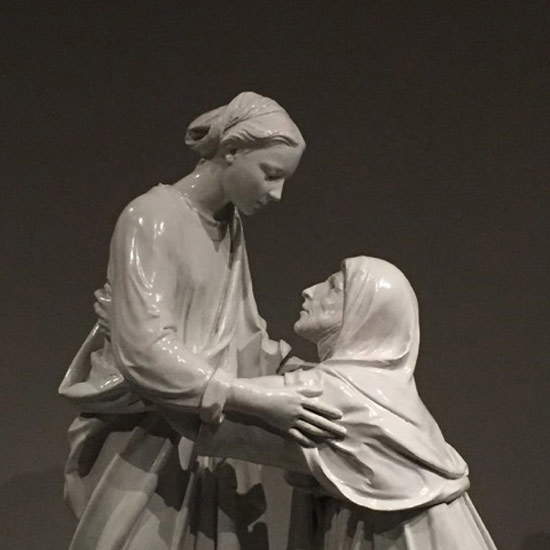 |
| Detail of the Visitation |
Robbia’s production in the sixteenth century, when by then, as Vasari decreed, the technique was experiencing a rapid decline, closes the exhibition. The family secret, which had left the workshop, had by then reached the hands of Benedetto and Santi Buglioni, the latter author of the trio of Franciscan Saints in the round now divided into three different collections. Striking is the vividness of these statues, which really manage to capture the attitude of the preachers before whom throngs of the faithful gathered. The explosion of the lower part of the St. John of Capestrano, patched up with new clay but nevertheless still visible, is perhaps indicative of a last attempt at experimentation through a medium that would only return to appreciation centuries later.
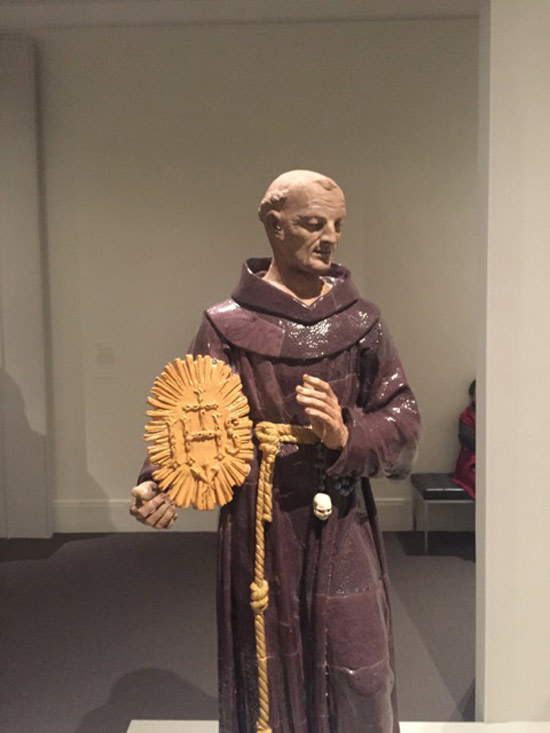 |
| Santi Buglioni, Saint Bernardine of Siena (c. 1550; glazed terracotta; Private collection) |
Indeed, preceded by the Kensington Museum, today’s Victoria and Albert in London, some American collectors and museums, especially in the early twentieth century, began to take an interest in glazed terracottas, causing a revival that also led to their counterfeiting. Several objects in the exhibition, including the aforementioned Resurrection of Christ, which entered the collections of the Brooklyn Institute, now the Brooklyn Museum in New York, in 1899, made their way into American collections, accompanied by triumphalist newspaper articles celebrating its arrival.
In the exhibition catalog, one of the six essays written by Marietta Cambareri, curator of the Boston museum’s collections of sculpture and decorative arts, has as its subject precisely the fortunes of glazed terracotta in the United States, to which it paved the way for that already encountered in the United Kingdom and the mediation of American and Italian art historians and connoisseurs. If between the fifteenth and sixteenth centuries glazed terracottas had reached, on the backs of mules, Urbino, Naples and Sicily and then, embarking, Portugal, France and England, at the beginning of the last century the robbiane reached even the New World, inspiring new suggestions and research.
Luca, Andrea and Giovanni would certainly have been proud of the endurance their works showed, surviving unscathed transoceanic voyages and keeping intact the vividness of their colors and the “authentic Tuscan small-town atmosphere” for which they were so prized by collectors at the beginning of the last century.
Warning: the translation into English of the original Italian article was created using automatic tools. We undertake to review all articles, but we do not guarantee the total absence of inaccuracies in the translation due to the program. You can find the original by clicking on the ITA button. If you find any mistake,please contact us.